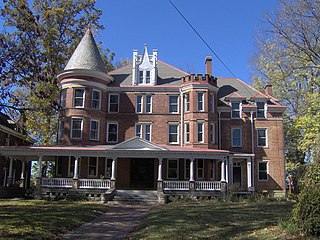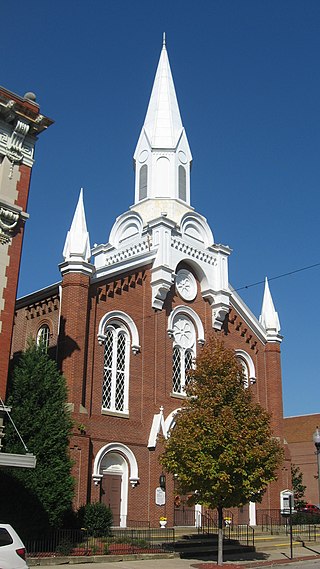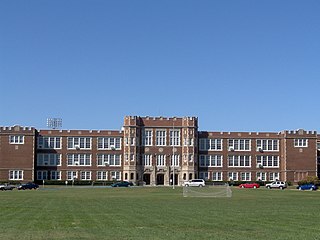
Blennerhassett Island Historical State Park is a state park located on Blennerhassett Island, a small island in the Ohio River, located in Wood County, West Virginia, USA. The property was the site of a Palladian mansion owned by Harman Blennerhassett, a participant in some of the alleged intrigues of Aaron Burr, and his wife Margaret Agnew. While the original mansion burned to the ground in 1811, a detailed replica, which can be toured, was built on its foundations in the 1980s. The Blennerhasset mansion greatly resembled George Washington's Mount Vernon, due to its Palladian style.

The Parkersburg Bridge crosses the Ohio River between Parkersburg, West Virginia, and Belpre, Ohio. Designed by Jacob Linville, the bridge has 46 spans: 25 deck plate girder, 14 deck truss, 6 through truss, and 1 through plate girder. 50,000 cubic yards (38,000 m3) of stone were used for the 53 piers. The bridge was constructed from May 1869 to January 1871 by the Baltimore and Ohio Railroad. At the time of its completion, the bridge was reportedly the longest in the world at 7,140 feet (2,180 m).

The Wood County Courthouse is a public building in downtown Parkersburg, West Virginia, in the United States. The courthouse was built in 1899 at a cost of $100,000 in the Richardsonian Romanesque style by local contractors Caldwell & Drake, according to the plans of architect L. W. Thomas of Canton, Ohio. The current courthouse is the fifth to be built in the county replacing one built in 1860. It was added to the National Register of Historic Places in 1979 for its architectural significance. During his 1912 presidential campaign Theodore Roosevelt stopped in Parkersburg and spoke from the Market street entrance of the courthouse. On 2 July 2020 a new steeple was added to the bell tower replacing one that had been removed in 1952. With the new steeple the courthouse is now the tallest in the state at 164 ft.

The Peter G. Van Winkle House was a historic home located in the Julia-Ann Square Historic District in Parkersburg, Wood County, West Virginia. It was built between about 1880 and 1899, and was a two-story duplex in the Queen Anne style. It featured a deck hipped roof with intersecting gables, turrets, and dormers. It was built on property once owned by former United States Senator Peter G. Van Winkle, who died in 1872.

The Julia-Ann Square Historic District, is a national historic district located at Parkersburg, Wood County, West Virginia. It is to the west of the Avery Street Historic District. It encompasses all houses on Ann and Juliana Streets from Riverview Cemetery to 9th Street. There are 116 contributing buildings and one contributing site. The majority of the houses were constructed between 1875 and 1915.

Bethel African Methodist Episcopal Church was a historic African Methodist Episcopal church located at 820 Clay Street in Parkersburg, Wood County, West Virginia. It was built in 1887 and was a two-story, stucco building in a vernacular interpretation of the Gothic Revival style. It was one of three black churches in Parkersburg and was the oldest black church building in west-central West Virginia. The church was located in a neighborhood of late 19th-century wood-frame houses only a block from downtown.

First Baptist Church is a historic Baptist church at 813 Market Street in Parkersburg, Wood County, West Virginia. It was built in 1871, and is a two-story, three by six-bay, brick church in the Italianate style, which was popular at the time. It has a central steeple on the front facade and several rear additions. It is topped by a gable roof trimmed by an arched corbel table and corner turret. This congregation was founded in 1817 and built their first church in 1837. First Baptist was built on that site.

First Presbyterian Church, also known as the Calvary Temple Evangelical Church and St. Patrick's Priory Church, is a historic church at 946 Market Street in Parkersburg, Wood County, West Virginia. It was built in 1894, and is a two-story, brick and stone church building in a combined Romanesque / Gothic Revival style. It features a corner bell tower.

Henry Logan Memorial African Methodist Episcopal Church is a historic African Methodist Episcopal church at Ann & 6th Streets in Parkersburg, Wood County, West Virginia. It was built in 1891, and is a brick and stone church building in a vernacular Romanesque style. It features three round arched stained glass windows on the front facade and a square, pyramidal roofed corner tower.

Trinity Episcopal Church Rectory is a historic church rectory at 430 Juliana Street in Parkersburg, Wood County, West Virginia. It is joined to the Trinity Episcopal Church located at 424 Juliana St., by a newer wing It was built in 1863, and is a 2+1⁄2-story, painted brick building in the Second Empire style. It features a concave profile mansard roof.

The Masonic Temple is a historic Masonic Lodge building located at Parkersburg, Wood County, West Virginia. It was built in 1915, and is a three-story, three-bay wide, red brick building with stone trim in the Classical Revival style. It features elliptical bays flanking the central bay on the front facade. The building was designed by Columbus architect Frank Packard with local supervising architect Theodore T. Sansbury.

The Elks Club was a historic clubhouse building located at Parkersburg, Wood County, West Virginia. It was designed by architect William Howe Patton and built in 1903. It was a four-story, three-bay by six-bay wide, red brick building with terra cotta trim in the Classical Revival style. The first two stories were faced in smooth dressed stone, and feature arched apertures, with central consoles. It was occupied by the Parkersburg Lodge #198, Benevolent and Protective Order of Elks (B.P.O.E.)

Parkersburg Women's Club is a historic clubhouse located at Parkersburg, Wood County, West Virginia. It was built between about 1860 and 1879, as a private home in the Italian Villa style. It is a two-story, frame building with a very low-pitched hipped roof. It features a one-story wraparound porch. It has housed the Parkersburg Women's Club since 1921.

The Mather Building, also known as Franklin & DeHaven Jewelers, was a historic commercial building located at Parkersburg, Wood County, West Virginia. It was built in 1898, and was a three- to four-story, red brick and sandstone building in the Classical style. The interior featured a fine tin ceiling and a built-in vault.

"Oakland," also known as the James M. Stephenson House, is a home located in Parkersburg, Wood County, West Virginia. Although a slaveholder and sympathizing with the Confederacy, Stephenson was also married to the sister of Unionist Arthur Boreman, and allowed then Union Army Col. James B. Steedman to use his grove nearby during the American Civil War. However, Union cavalry units occupied this his mansion for a time nonetheless, and damaged furnishings as well as the home and garden.

Tavenner House is a historic home located at Parkersburg, Wood County, West Virginia. The main house was built about 1812, and is a two-story, brick house coated in stucco in the Federal style. It has a gable roof and sits on a foundation of cut stone slabs. The property includes a 1+1⁄2-story frame dependency with a gable roof and covered in novelty siding. It is the oldest remaining building in the Parkersburg area and is associated with Colonel Thomas Tavenner, a prominent early settler of this area.

House at 10th and Avery Streets is a historic home located at Parkersburg, Wood County, West Virginia. It was built between about 1860 and 1879, and is a two-story, frame house in the Eastlake / Carpenter Gothic style. Its roof has a complex composition of hips and gabled wall dormers, pierced by two brick chimney. The house features sawn woodwork that make it the most highly ornamented residential building in downtown Parkersburg.

Henry Cooper House, also known as The Daughters of American Pioneers Museum and Cooper Cabin, is a historic home located at Parkersburg, Wood County, West Virginia. The log cabin was erected in Slate District, Wood County, in 1804, by Henry Cooper, and is believed to be the first two-story log cabin in Wood County. In August 1910, the City of Parkersburg purchased the structure for $400. After being dismantled, the house was rebuilt in the Park in September 1910. In 1911, title was granted by the City Council to the Centennial Chapter - Daughters of American Pioneers. The cabin is open as a museum.

Avery Street Historic District, is a national historic district located at Parkersburg, Wood County, West Virginia. It is to the east of the Julia-Ann Square Historic District and south of the Parkersburg High School-Washington Avenue Historic District. Primarily residential, it encompasses 109 acres and includes churches, a school, and a small commercial area. Built as Parkersburg's first "suburb" in the late-19th and early-20th century in popular architectural style such as Colonial Revival and Queen Anne, the district exhibits 12 distinctive types of Historic architecture. There are 358 contributing buildings, 59 of which are considered to be pivotal. U.S. Senator Johnson N. Camden (1826-1908) owned most of the land now included in the district. Located in the district are the separately listed Parkersburg Women's Club and the First Presbyterian Church/Calvary Temple Evangelical Church.

Parkersburg High School–Washington Avenue Historic District, is a national historic district located at Parkersburg, Wood County, West Virginia. The Parkersburg High School was built in 1917 north of the Avery Street Historic District in the Jacobethan Revival style. It was designed by Ohio architect Frank Packard (1866-1923).
























